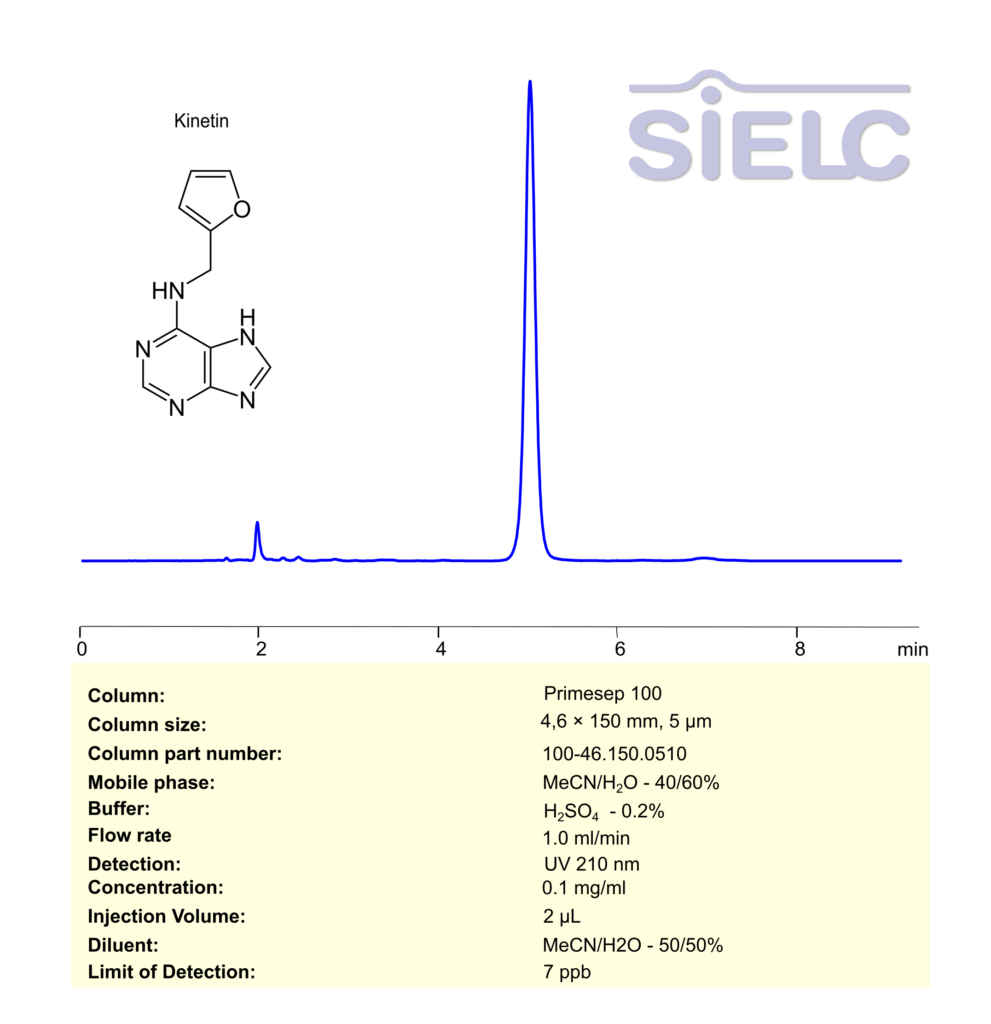High Performance Liquid Chromatography (HPLC) MS Method for Analysis of Kinetin on Primesep 100 by SIELC Technologies
Separation type: Liquid Chromatography Mixed-mode SIELC Technologies

High Performance Liquid Chromatography (HPLC) Method for Analysis of Kinetin
Kinetin is a type of cytokinin, a class of phytohormones that play a crucial role in promoting cell division, growth, and delaying aging (senescence) in plants. It was one of the first cytokinins discovered and is often used in plant tissue culture and agriculture to enhance plant growth and development. Kinetin is a powerful cytokinin that is critical for cell division, shoot formation, and delaying aging in plants. Its application spans plant tissue culture, agriculture, and even the cosmetic industry.
Key Functions of Kinetin:
- Cell Division: Kinetin promotes cytokinesis (cell division), making it essential for plant tissue growth and regeneration.
- Shoot Formation: It supports the development of shoots and leaves, particularly in tissue culture where it helps balance root-to-shoot growth.
- Delay of Senescence: Kinetin delays the aging process in leaves by maintaining chlorophyll levels and preventing leaf yellowing, effectively slowing down senescence.
- Nutrient Mobilization: It helps in the transport and mobilization of nutrients within the plant, encouraging overall plant vitality and health.
Kinetin was first isolated from degraded DNA in herring sperm in 1955, though it is not commonly found in high concentrations in plants compared to other cytokinins like zeatin. However, kinetin is naturally occurring and has been detected in various plant tissues.
Applications:
- Plant Tissue Culture: Kinetin is frequently used in tissue culture media to promote shoot initiation and growth. It helps in the regeneration of plants from callus and explants.
- Agriculture: Kinetin is used to increase crop yields, improve seedling growth, and extend the shelf life of fruits and vegetables by delaying senescence.
- Cosmetics: Kinetin is also used in anti-aging skin care products due to its ability to delay aging processes in human skin cells, similar to how it affects plant tissues.
Mechanism of Action:
Kinetin binds to cytokinin receptors in plants, initiating a signaling cascade that leads to gene expression changes, promoting cell division and growth. Its action is often in opposition to auxins, and both hormones work together to balance root and shoot growth.
Kinetin can be retained, separated and analyzed using a Primesep 100 mixed-mode stationary phase column. The analysis employs an isocratic method with a simple mobile phase comprising water, acetonitrile (MeCN), and sulfuric acid as a buffer. This method allows for detection using UV 210 nm.
You can find detailed UV spectra of Kinetin and information about its various lambda maxima by visiting the following link.
| Column | Primesep 100, 4.6 x 150 mm, 5 µm, 100 A, dual ended |
| Mobile Phase | MeCN – 40% |
| Buffer | H2SO4 -0.2% |
| Flow Rate | 1.0 ml/min |
| Detection | UV 210 nm |
| Sample | 0.1 mg/ml |
| Diluent | MeCN/H2O- 50/50% |
| LOD* | 7 ppb |
| Class of Compounds | Phytohormone |
| Analyzing Compounds | Kinetin |
Application Column
Primesep 100
Column Diameter: 4.6 mm
Column Length: 150 mm
Particle Size: 5 µm
Pore Size: 100 A
Column options: dual ended





